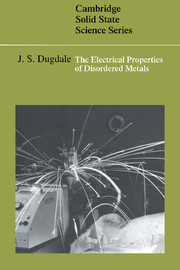Book contents
- Frontmatter
- Contents
- Preface
- 1 Context and content
- 2 Production and structure of metallic glasses
- 3 Electron transport in metals: introduction to conventional theory
- 4 Scattering
- 5 Simple liquid metals: Ziman theory
- 6 Phonons in disordered systems
- 7 Interactions and quasi-particles
- 8 Transition metals and alloys
- 9 The Hall coefficient of metallic glasses
- 10 Magnetoresistance
- 11 Electrical conductivity of metallic glasses: weak localisation
- 12 The interaction effect or Coulomb anomaly
- 13 The effect of the Coulomb interaction on conductivity
- 14 Influence of a magnetic field on the enhanced interaction effect
- 15 The thermopower of metals and alloys
- 16 Comparison with experiment
- Appendices
- Notes
- References
- Index
7 - Interactions and quasi-particles
Published online by Cambridge University Press: 21 January 2010
- Frontmatter
- Contents
- Preface
- 1 Context and content
- 2 Production and structure of metallic glasses
- 3 Electron transport in metals: introduction to conventional theory
- 4 Scattering
- 5 Simple liquid metals: Ziman theory
- 6 Phonons in disordered systems
- 7 Interactions and quasi-particles
- 8 Transition metals and alloys
- 9 The Hall coefficient of metallic glasses
- 10 Magnetoresistance
- 11 Electrical conductivity of metallic glasses: weak localisation
- 12 The interaction effect or Coulomb anomaly
- 13 The effect of the Coulomb interaction on conductivity
- 14 Influence of a magnetic field on the enhanced interaction effect
- 15 The thermopower of metals and alloys
- 16 Comparison with experiment
- Appendices
- Notes
- References
- Index
Summary
The validity of the independent electron picture
We have treated the electrons as effectively independent particles subject to occasional scattering processes even though we know that there are strong Coulomb forces between electrons and between electrons and ions. This picture certainly has some validity which can be partly understood in the following way. First of all, as we have seen in Chapter 4, the range of the Coulomb interaction between electrons is screened out over a distance of the order of the interionic separation because the conduction electrons are attracted to the neighbourhood of the positive ions and so produce electrical neutrality when viewed from a short distance away. Thus the cross-section for scattering of an electron is of the same order as that of an ion, i.e. of atomic dimensions.
Second, the Pauli exclusion principle drastically reduces the number of processes by which conduction electrons can interact and be scattered by other conduction electrons. We can see this from the following argument. Consider an electron gas at absolute zero with all the states up to E0 filled and those above empty. Assume that we give one electron a small amount of energy ε above E0. It can only be scattered by another electron in the Fermi sea if, after the collision, both particles have empty states of the right energy to go to. This means that, since energy is conserved in the collision, the initial state of the second electron must lie within an energy range ε of the Fermi level; otherwise the collision could not raise its energy above E0 where there are empty states.
- Type
- Chapter
- Information
- The Electrical Properties of Disordered Metals , pp. 63 - 70Publisher: Cambridge University PressPrint publication year: 1995



